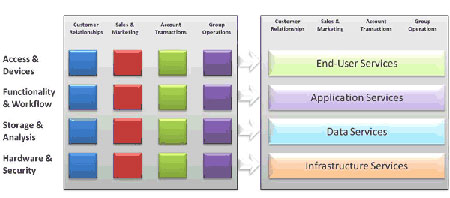
Silo-based vs. layered platform architectures in M&As
When merger or acquisition bring two organizations together, according to Roger Evernden, "decision makers face the difficulty of deciding how much integration is necessary or possible, and how to achieve consolidation, standardization, and rationalization between two often diverse and divergent systems."
Evernden goes on to state that "Generally speaking, when functionality -- such as handling customer relationships, sales and marketing, account transactions, or group operations -- is architected as standalone silos, it will be much harder to integrate or divest. Most organizations are heading toward architectures that provide layered platforms of services -- such as end-user services, applications services, data services, and infrastructure services -- that combine to support particular functional areas. These platforms provide separate layers for things like access and devices, functionality and workflow, storage and analysis, or hardware and security."
* Excerpted from " Existing Architectures and EA Practice," (![]() ) Business & Enterprise Architecture Advisor, 9 April 2014
) Business & Enterprise Architecture Advisor, 9 April 2014
Get stats and charts like these in your inbox, free!
The Cutter Edge is a free biweekly email service that gives you information and advice that you can put to work immediately for your organization. Issues are written by Cutter Consortium's journal and Senior Consultants.

